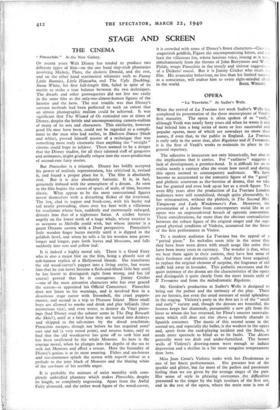STAGE AND SCREEN
THE CINEMA
" Pinocchio." At the New Gallery.
OF recent years Walt Disney has tended to produce two different types of film—on the one hand slap-stick phantasies involving Mickey, Pluto, the choleric Donald, and the rest, and on the other hand sentimental whimsies such as Funny Little Bunnies, Little Hiawatha, and The Ugly Duckling. Snow White, his first full-length film, failed in spite of its merits to strike a true balance between the two techniques. The dwarfs and other grotesqueries did not live too easily in the same film as the only-too-almost-human figures of the heroine and the hero. The real trouble was that Disney's cartoon methods had been perfected to such an extent that an almost photographic realism could be achieved. It was significant that The Wizard of Oz reminded one at times of Disney, despite the brittle and uncompromising camera-realism of many of its sets and characters. This similarity, however good Oz may have been, could not be regarded as a compli- ment to the man who had earlier, in Skeleton Dance (black and white), proved himself master of a technique that was something more truly cinematic than anything the " straight " cinema could hope to achieve. There seemed to be a danger that the Disney studios, for all their talented staff of gangsters and animators, might gradually relapse into the mass-production of second-rate fairy stories.
But Pinocchio is a triumph. Disney has boldly accepted his power of realistic representation, has criticised it, revised it, and found a proper place for it. The film is absolutely real. But it is also absolutely fantastic. It is, in fact, genuinely imbued with the atmosphere of a dream. As soon as the film begins the senses of space, of scale, of time, become elastic. What appear to be the most conventional figures invest themselves with a disturbing flicker of the irrational. The fox, clad in topper and frock-coat, with his bushy red tail neatly protruding, chats over his beer with a villainous fat coachman whose face, suddenly and enormously enlarged, distorts into that of a nightmare Satan. A cricket batters angrily on the lower teeth of a huge whale, whose exterior is as accurate as Melville could wish, but whose interior -is a gaunt Otranto cavern with a Dore perspective. Pinocchio's little wooden finger burns merrily until it is dipped in the goldfish bowl, and when he tells a lie his wooden nose grows longer and longer, puts forth leaves and blossoms, and falls suddenly into sere and yellow leaf.
It is indeed a highly moral tale. There is a Good Fairy who is also a major blot on the film, being a ghastly sort of sub-human replica of a Hollywood blonde. She transforms the old wood-carver's puppet into a living entity, but warns him that he can never become a flesh-and-blood little boy until he has learnt to distinguish right from wrong, and has (of course) proved that he is courageous. Jiminy Cricket —one of the most attractive characters who has ever graced the screen—is appointed his Official Conscience. Pinocchio does not listen to his warnings, and is involved first in a disastrous stage career with Stromboli, the cruel puppet- master, and second in a trip to Pleasure Island. Here small boys are allowed to smoke and drink and play billiards (that mysterious vice), and even worse, to destroy da Vinci paint- ings (had Disney read the cabaret scene in The Dog Beneath the Skin?), until at a fatal hour they are turned into donkeys and shipped to the salt-mines by the dread coachman.- Pinocchio escapes, though not before he has acquired asses' ears and tail (a very moral point), and returns home, only to find that the old woodcarver has gone off to seek him and has been swallowed by the whale Monstro. So here is the courage moral, when he plunges into the depths of the sea to seek out Monstro and effect a rescue. Here the fecundity of Disney's genius is at its most amazing. Fishes and sea-horses and sea-anemones splash the screen with superb colour as a prelude to the jetty black of Monstro and the blazing white of the sea-foam of his terrible anger.
It is probably the mixture of strict morality with com- pletely unbridled phantasy which makes Pinocchio, despite its length, so completely engrossing. Apart from the Awful Fairy aforesaid, and the rather weak figure of the wood-carver, it is crowded with some of Disney's finest characters—Cleo coquettish goldfish, Figaro the uncompromising kitten, and least the villainous fox, whose luscious voice, issuing as it v. simultaneously from the throats of John Barrymore and W. Fields, wraps Pinocchio in the treacly and sinister suggesti, of a Dickens' rascal. But it is Jiminy Cricket who steal,, film. His avuncular behaviour, no less than his limited suc, as a conscience, will endear him to every right-minded ci






































 Previous page
Previous page